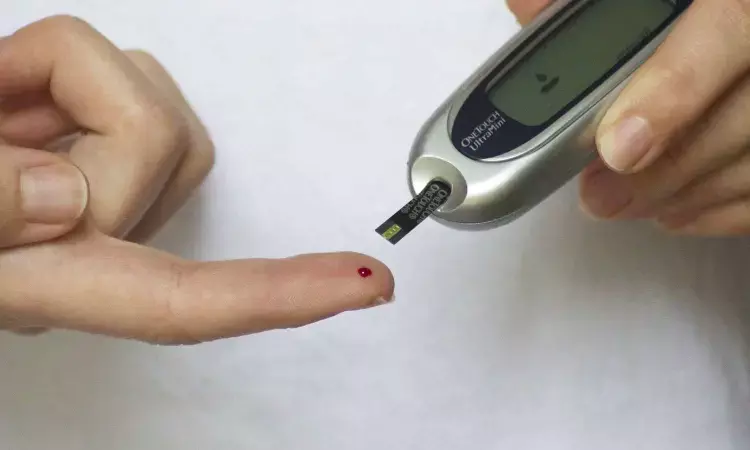- Home
- Medical news & Guidelines
- Anesthesiology
- Cardiology and CTVS
- Critical Care
- Dentistry
- Dermatology
- Diabetes and Endocrinology
- ENT
- Gastroenterology
- Medicine
- Nephrology
- Neurology
- Obstretics-Gynaecology
- Oncology
- Ophthalmology
- Orthopaedics
- Pediatrics-Neonatology
- Psychiatry
- Pulmonology
- Radiology
- Surgery
- Urology
- Laboratory Medicine
- Diet
- Nursing
- Paramedical
- Physiotherapy
- Health news
- Fact Check
- Bone Health Fact Check
- Brain Health Fact Check
- Cancer Related Fact Check
- Child Care Fact Check
- Dental and oral health fact check
- Diabetes and metabolic health fact check
- Diet and Nutrition Fact Check
- Eye and ENT Care Fact Check
- Fitness fact check
- Gut health fact check
- Heart health fact check
- Kidney health fact check
- Medical education fact check
- Men's health fact check
- Respiratory fact check
- Skin and hair care fact check
- Vaccine and Immunization fact check
- Women's health fact check
- AYUSH
- State News
- Andaman and Nicobar Islands
- Andhra Pradesh
- Arunachal Pradesh
- Assam
- Bihar
- Chandigarh
- Chattisgarh
- Dadra and Nagar Haveli
- Daman and Diu
- Delhi
- Goa
- Gujarat
- Haryana
- Himachal Pradesh
- Jammu & Kashmir
- Jharkhand
- Karnataka
- Kerala
- Ladakh
- Lakshadweep
- Madhya Pradesh
- Maharashtra
- Manipur
- Meghalaya
- Mizoram
- Nagaland
- Odisha
- Puducherry
- Punjab
- Rajasthan
- Sikkim
- Tamil Nadu
- Telangana
- Tripura
- Uttar Pradesh
- Uttrakhand
- West Bengal
- Medical Education
- Industry
Diabetic children fail to set CGM alarms to alert them to dangerously low or high blood sugar levels

USA: A recent study has shed light on a factor that makes continuous glucose monitors (CGM) less useful in tracking glucose levels among children and teenagers.
The study, presented at ENDO 2023, the Endocrine Society’s annual meeting in Chicago, Ill, revealed that children and teens using CGM for diabetes management often fail to use the appropriate alarm settings to alert to dangerously low or harmful high blood sugar levels.
Children and teenagers who use continuous glucose monitors (CGM) to manage diabetes often fail to use the appropriate alarm settings to alert to dangerously low or harmful high blood sugar levels, according to a study being presented Thursday at ENDO 2023, the Endocrine Society’s annual meeting in Chicago, Ill. This variability makes the monitors less useful in tracking glucose levels.
Children with diabetes employ many CGM alarm settings and cutoffs, many of which differ significantly from recommended values. According to researcher Victoria Ochs of Indiana University School of Medicine, the study found it was more common for patients and parents to set fewer alarms than recommended.
Ochs said that ensuring CGM alarm best practices are followed will help children with diabetes and their caregivers get needed real-time glycemic data while minimizing alarm fatigue.
“Patients make their alarm glucose thresholds too sensitive, so they learn to tune out the alarms, similar to how we tune out a phone that has been ringing or a car maintenance alarm,” she said.
Continuous glucose monitors automatically track glucose levels throughout the day and night. They allow a person to see their glucose level anytime at a glance. A person using CGM can also review how glucose changes over a few hours or days to see trends. Seeing glucose levels in real-time can help make more informed daily decisions about balancing food, physical activity and medicines, including insulin.
It is important to keep blood glucose levels in the targeted range. Over time, high blood glucose levels can harm blood vessels, the heart, kidneys, eyes and nerves, leading to serious health problems. Dangerously low blood glucose levels, or hypoglycemia, can lead to seizures, coma or even death.
CGMs offer customizable alarms that can be adjusted to provide glucose information to patients and caregivers. However, few data exist on how real-time CGM alarms are used in large clinical pediatric populations.
This study included 150 children and teenagers with diabetes using Dexcom G6 continuous glucose monitoring devices at a large pediatric diabetes center. The researchers evaluated summaries printed from the devices that indicated alarm use and settings over two weeks.
The data revealed children with diabetes and their parents use a large range of alarm settings and values for notification. Only 87 percent of the study participants had set low alarm alerts, and 73 percent had set high alarm alerts. There were often significant differences between patients' settings and recommended values. Children using insulin pumps and patients under age 12 years were more likely to employ alarms.
“Overall, the wide variability of observed alarm settings indicates likely educational gaps in CGM onboarding and use,” Ochs said. “This study shows that there is both the opportunity for the diabetes health care team to mention alarm use best practices during onboarding and to continue to message and work with patients and families to optimize use on an ongoing basis.”
Reference:
CGM alarms often not set to alert children with diabetes to harmful blood glucose fluctuations, The Endocrine Society, Meeting, ENDO 2023, the Endocrine Society's annual meeting.
Dr Kamal Kant Kohli-MBBS, DTCD- a chest specialist with more than 30 years of practice and a flair for writing clinical articles, Dr Kamal Kant Kohli joined Medical Dialogues as a Chief Editor of Medical News. Besides writing articles, as an editor, he proofreads and verifies all the medical content published on Medical Dialogues including those coming from journals, studies,medical conferences,guidelines etc. Email: drkohli@medicaldialogues.in. Contact no. 011-43720751


